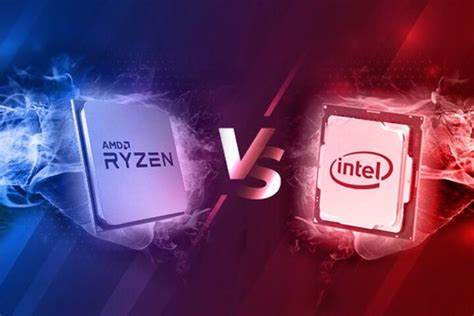In the fast-paced world of computing, the two giant competitors, Advanced Micro Devices (AMD) and Intel Corporation (Intel), have been entangled in an ongoing battle for dominance in the CPU market. For decades, these two companies have vied for supremacy, each striving to offer the best performance, power efficiency, and innovation to cater to the diverse needs of users worldwide. In this blog post, we will explore the history, strengths, weaknesses, and recent developments of AMD and Intel CPUs, providing a comprehensive analysis of their competition.
Historical Overview
The rivalry between AMD and Intel dates back to the late 1960s when both companies were founded. Intel established itself as a market leader early on, paving the way for the development of microprocessors. AMD followed suit, entering the CPU market in the 1980s, initially as a manufacturer of clone chips for Intel processors. As time progressed, AMD developed its microprocessors, breaking away from the Intel architecture and introducing its own innovations, such as 64-bit computing and multi-core processors.
Performance Battle
Over the years, both companies have engaged in a relentless pursuit of raw performance, with each introducing CPUs that showcase their cutting-edge technologies. In the early 2000s, AMD gained an edge over Intel with its Athlon processors, which offered competitive performance at a more affordable price. Intel countered with its Core series, launching the Core 2 Duo, which re-established its dominance in the market. The competition spurred both companies to push the boundaries of CPU design, resulting in significant leaps in performance with each generation.
Innovation and Technological Advancements
Innovation has been a driving force behind the AMD vs. Intel rivalry. Both companies have been responsible for groundbreaking technologies that have shaped the computing landscape. AMD made a substantial leap with the introduction of the AMD64 architecture, which brought 64-bit computing to mainstream consumers. Intel, on the other hand, introduced Hyper-Threading and Turbo Boost technologies, further enhancing multitasking capabilities and single-core performance.
The more recent innovation battleground centers around manufacturing process technology. Both AMD and Intel have been transitioning to smaller process nodes to improve power efficiency and performance. AMD’s Ryzen CPUs are built on its “Zen” microarchitecture, while Intel introduced its 10nm and 7nm processes for better energy efficiency and higher transistor density.
Market Segments and Price Competitiveness
AMD and Intel CPUs cater to various market segments, targeting different audiences. Historically, AMD has been known for offering competitive options for budget-conscious consumers, providing excellent value for money with its mid-range and entry-level processors. Intel, on the other hand, has been associated with high-end, premium CPUs that are often priced at a premium.
However, this distinction has blurred in recent years. AMD’s Ryzen processors have emerged as formidable contenders in the high-performance segment, challenging Intel’s Core i9 processors in terms of raw processing power. Additionally, AMD’s aggressive pricing strategy has forced Intel to be more competitive in the mid-range and budget-friendly markets.
Gaming Performance
Gaming performance is a crucial consideration for many users when choosing a CPU. Historically, Intel CPUs have been preferred by gamers due to their slightly better single-core performance, which is often more critical for gaming applications. However, AMD has made significant strides in closing this gap with its Ryzen processors, which boast strong multi-core performance and better price-to-performance ratios.
Furthermore, gaming performance is not solely determined by the CPU; the choice of GPU and other system components can also influence the overall gaming experience. Both AMD and Intel CPUs are compatible with a wide range of GPUs, so users can build gaming systems tailored to their preferences.
Integrated Graphics
Integrated graphics have become an essential feature for many users, especially those seeking compact form factors and basic computing tasks. Intel has long been a leader in this area, offering powerful integrated graphics solutions with its Intel HD Graphics and Iris Xe Graphics, which can handle casual gaming and video playback with ease. AMD’s Ryzen APUs, which combine CPU and GPU cores on the same chip, have also made significant strides in integrated graphics performance, providing viable alternatives for users who need capable integrated graphics solutions.
Conclusion
The AMD vs. Intel CPU rivalry has been a driving force behind the relentless innovation and improvement in the PC market. Both companies have made significant contributions to computing technology, bringing us to the era of multi-core processors and advanced manufacturing processes. The competition between AMD and Intel has been a win-win situation for consumers, as it has resulted in better performance, increased value for money, and more choices than ever before.
Ultimately, the choice between AMD and Intel CPUs boils down to individual needs and preferences. AMD’s Ryzen processors have become synonymous with excellent multi-core performance and value, while Intel’s offerings remain the go-to choice for single-core performance and robust integrated graphics. As both companies continue to push the boundaries of CPU technology, we can expect even more exciting innovations that will further shape the future of computing.

